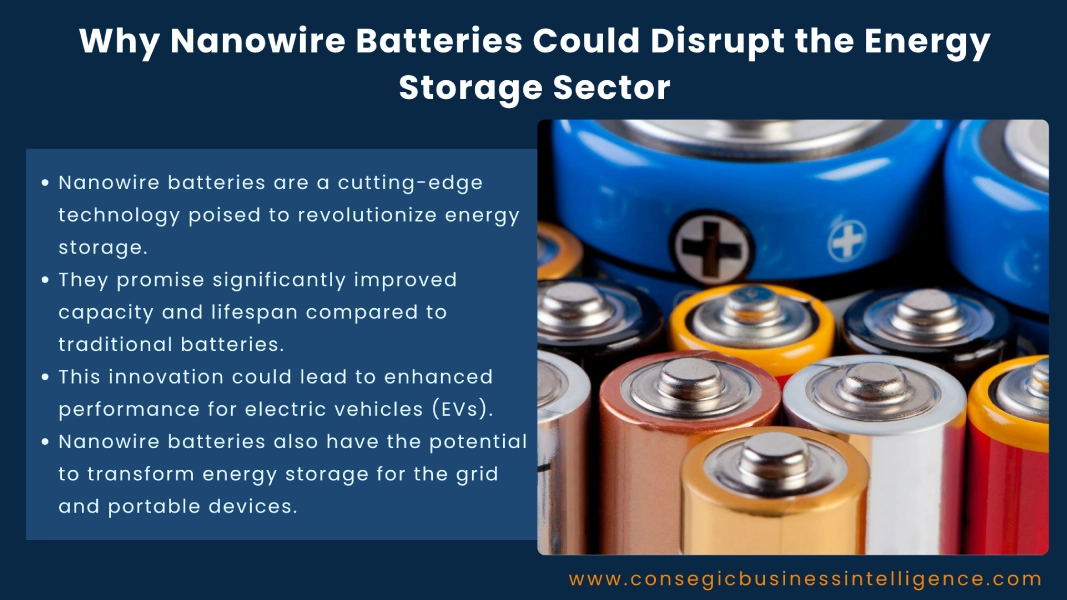Why Nanowire Batteries Could Disrupt the Energy Storage Sector
As the world continues to move towards cleaner, more eco-friendly energy sources, innovation in batteries is at the forefront of the industry. One of the technologies that are following closely is the nanowire battery which is winning a lot of hearts for its potential to significantly improve the capacity and lifespan of the traditional energy storage systems. This futuristic power storage could not only lead to enhanced electric vehicle (EV) performance but also revolutionize energy storage for grid and portable devices. Here is the explanation of nanowire batteries becoming the main players in the energy storage scene.

What Are Nanowire Batteries?
Nanowire batteries are a subtype of lithium-ion batteries having wires on the nanoscale, in the range of nanometers, which are typically made of silicon or other conductive materials as the anode. Such nanowire anodes differ from the traditional graphite ones only in that they provide a larger surface area about electrical conductivity. This scaffolding allows for deeper insertion of lithium ions and faster electrode processes, thus increasing battery energy density and reducing charge times. The breakthrough is not only about the material itself but also the microscopic fashion in which the structure is designed in order to optimize function and lifespan.
One of the well-known problems of lithium-ion batteries is that they have a limited number of cycles. The battery losing its characteristics over time because of various charging and discharging processes, which are mainly caused by the materials' structural breakdown. Nanowire batteries, particularly the ones consisting of silicon, can preserve their structure even after a huge number of cycles. For instance, researchers at the University of California, Irvine, have developed a nanowire-based battery that can be charged/discharged more than 200,000 times with virtually no degradation, a milestone never before attained in battery research. This renders nanowire batteries most fitting for projects where it is crucial to have durable and reliable devices, such as electric cars and energy units.
Faster Charging and Higher Energy Density
Energy density and charging speed are the most important factors that define battery performance. Conventional lithium-ion batteries can take hours to charge and may not have enough energy storage for long use. The high surface-to-volume ratio of nanowire structures allows not only faster movement of electrons but also that of lithium ions, hence leading to rapid charging. Additionally, batteries made from nanowires have a higher energy density, so they can store more energy per unit volume, which means a longer battery life for the same physical size. For electric cars, this might translate into fewer charging stops and shorter wait times, both of which are critical for widespread use.
Solving the Problem of Silicon Expansion
For a very long time, silicon was only considered as a material that was potentially more suitable as an anode than graphite if appropriately used, but due to a small problem it has not been utilized extensively-i.e., silicon expands up to 400% upon charging which eventually causes cracking and short circuits. On the other hand, nanowire forms solve the problem, in addition, they make room for expansion at the microscale. Besides, nanowires by virtue of being very thin and elastic, are able to bulge and contract without losing their integrity thus, silicon can serve as a practical and stable alternative if one is to consider battery anode material in the future. Apart from this, the adaptation could be the last barrier removed from the potential appeal of silicon-based batteries.
Impact on Renewable Energy Integration
Since renewable sources such as solar and wind are intermittent in nature, reliable energy storage with good performance becomes necessary to maintain a steady supply of power. Nanowire batteries which are given new life by their significantly higher capacity and longer life are ideally suited for energy storage on the grid. Moreover, their short charging time, and energy efficiency during discharge, can help energy management handle a smoother load shifting while also generating less loss. The new battery technology such as nanowire systems will be like an energy store for energy transition into clean energy worldwide, hence they are crucial in coming down to net zero and in the quest of wind and solar integration.
Market Implications and Future Outlook
Nanowire batteries are still in the research stage and being commercialized in a limited way but they are already catching the eye of several startups and established companies that are pouring money into them. The energy storage market for the whole world which has already been expanding very fast could get a huge boost if these batteries get produced in bulk. The issues of cost, scalability, and stability over time have to be resolved yet but the basic science is solid. The nanowire batteries have a chance of becoming a substitute for the lithium-ion ones in many sectors, with this scenario being possible due to the scientific community’s and market’s interest and the subsequent research progress.
Final Thoughts
The scope of nanowire batteries may be beyond merely going a step further, but rather they emerge as a radical idea of storing and managing the energy. Nanowire batteries that come from superior charging cycles, high energy density, and flexibility are perfectly placed to shake the energy storage sector to its core. Since the world intends to switch to electric vehicles and renewable energy, these batteries will most probably be among the essential technologies leading the way to the new era.
